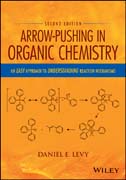
Arrow-Pushing in Organic Chemistry: An Easy Approach to Understanding Reaction Mechanisms
Levy, Daniel E.
Organic chemistry is required coursework for degrees in life, food, and medical sciences. To help the students discouraged by the belief that this topic cannot be mastered without significant memorization, Arrow Pushing in Organic Chemistry serves as a handy supplement for understanding the subject. Includes new chapters, an expanded index, and additional problem sets complete with detailed solutions Focuses on understanding the mechanics and logic of organic reaction mechanisms Introduces ionic and non–ionic reactive species and reaction mechanisms Teaches strategies to predict reactive species, sites of reactions, and reaction products Provides a solid foundation upon which organic chemistry students can advance with confidence INDICE: PREFACE xi .ACKNOWLEDGEMENTS xiii .ABOUT THE AUTHOR xv .1. Introduction 1 .1.1 Definition of Arrow–Pushing 1 .1.2 Functional Groups 5 .1.3 Nucleophiles and Leaving Groups 7 .1.4 Summary 8 .Problems 9 .2. Free Radicals 19 .2.1 What Are Free Radicals? 19 .2.2 How Are Free Radicals Formed? 21 .2.2.1 Free Radical Initiators 22 .2.2.2 Electron Transfer 23 .2.3 Free Radical Stability 23 .2.4 What Types of Reactions Involve Free Radicals? 25 .2.4.1 Halogenation Reactions 26 .2.4.2 Polymerization Reactions 28 .2.4.3 Oxidation Reactions 30 .2.5 Summary 31 .Problems 32 .3. Acids 37 .3.1 What Are Acids? 37 .3.2 What Is Resonance? 38 .3.3 How Is Acidity Measured? 41 .3.4 Relative Acidities 42 .3.5 Inductive Effects 47 .3.6 Inductive Effects and Relative Acidities 49 .3.7 Relative Acidities of Hydrocarbons 50 .3.8 Summary 51 .Problems 52 .4. Bases and Nucleophiles 61 .4.1 What Are Bases? 61 .4.2 What Are Nucleophiles? 66 .4.3 Leaving Groups 70 .4.4 Summary 70 .Problems 71 .5. SN2 Substitution Reactions 81 .5.1 What Is An SN2 Reaction? 81 .5.2 What Are Leaving Groups? 83 .5.3 Where Can SN2 Reactions Occur? 84 .5.4 SN2 Reactions 85 .5.5 Summary 88 .Problems 89 .6. SN1 Substitution Reactions 97 .6.1 What Is An SN1 Reaction? 97 .6.2 How Are SN1 Reactions Initiated? 98 .6.3 The Carbocation 99 .6.3.1 Molecular Structure and Orbitals 100 .6.3.2 Stability of Carbocations 103 .6.4 Carbocation Rearrangements 105 .6.4.1 1,2–Hydride Shifts 105 .6.4.2 1,2–Alkyl Shifts 106 .6.4.3 Preventing Side Reactions 109 .6.5 Summary 109 .Problems 110 .7. Elimination Reactions 115 .7.1 E1 Eliminations 115 .7.2 E1cB Eliminations 118 .7.3 E2 Eliminations 120 .7.4 How Do Elimination Reactions Work? 121 .7.5 E1cB Eliminations Versus E2 Eliminations 124 .7.6 Summary 124 .Problems 126 .8. Addition Reactions 133 .8.1 Addition of Halogens to Double Bonds 133 .8.2 Markovnikov s Rule 135 .8.3 Additions to Carbonyls 137 .8.3.1 1,2–Additions 137 .8.3.2 1,4–Additions 138 .8.3.3 Addition Elimination Reactions 141 .8.4 Summary 143 .Problems 144 .9. Carbenes 153 .9.1 What Are Carbenes? 153 .9.2 How Are Carbenes Formed? 154 .9.3 Reactions with Carbenes 156 .9.3.1 Carbene Dimerization 156 .9.3.2 Cyclopropanation Reactions 157 .9.3.3 O–H Insertion Reactions 161 .9.4 Carbenes Versus Carbenoids 162 .9.5 Summary 163 .Problems 164 .10. Pericyclic Reactions 171 .10.1 What Are Pericyclic Reactions? 171 .10.2 Electrocyclic Reactions 172 .10.3 Cycloaddition Reactions 175 .10.3.1 The Diels Alder Reaction 175 .10.3.2 The Ene Reaction 178 .10.3.3 Dipolar Cycloaddition Reactions 180 .10.4 Sigmatropic Reactions 182 .10.4.1 The Cope Rearrangement 183 .10.4.2 The Claisen Rearrangement 184 .10.5 Summary 187 .Problems 189 .11. Moving Forward 195 .11.1 Functional Group Manipulations 195 .11.2 Name Reactions 196 .11.3 Reagents 208 .11.4 Final Comments 208 .Problems 209 .Appendix 1. pKa Values of Protons Associated with Common Functional Groups 219 .Appendix 2. Answers and Explanations to Problems 223 .Chapter 1 Solutions 224 .Chapter 2 Solutions 234 .Chapter 3 Solutions 241 .Chapter 4 Solutions 258 .Chapter 5 Solutions 270 .Chapter 6 Solutions 285 .Chapter 7 Solutions 293 .Chapter 8 Solutions 303 .Chapter 9 Solutions 318 .Chapter 10 Solutions 334 .Chapter 11 Solutions 347 .Appendix 3. Student Reaction Glossary 369 .Index 373 .Periodic Table of Elements 401
- ISBN: 978-1-118-99132-9
- Editorial: Wiley–Blackwell
- Encuadernacion: Rústica
- Páginas: 424
- Fecha Publicación: 31/03/2017
- Nº Volúmenes: 1
- Idioma: Inglés
